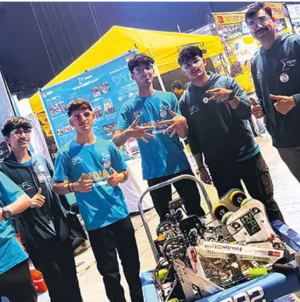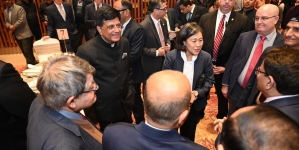-
CANBERRA: India-Australia partnership aims to bridge skill gap for future employment - April 15, 2024
-
HOUSTON: Mumbai boys in the final rounds of FIRST World Robotics competition to be held in Houston - April 14, 2024
-
MADRAS: IIT Madras NPTEL translates thousands of technical courses into several regional languages - April 10, 2024
-
MUMBAI: Shahid Kapoor opens up about the challenges faced by character actors in Bollywood - April 8, 2024
-
NEW DELHI: World Health Day 2024: Date, Theme, History, Significance and Interesting Facts - April 6, 2024
-
LONDON: Indian-Origin Teen In UK Gets “Life-Changing” Cancer Treatment - April 3, 2024
-
BENGALURU: Indian scientists unravel genetic secrets behind lumpy skin disease outbreak - March 30, 2024
-
NEW DELHI: Youngsters’ Increasing Stress Levels, Early Onset of Diseases an Alarming Health Trend: Apollo Hospitals Chief - March 28, 2024
-
MARYLAND: All About Pavan Davuluri, New Head Of Microsoft Windows - March 27, 2024
-
MUMBAI: Pyaar Kiya To Darna Kya turns 26: Kajol says THIS was the symbol of an innocent girl back then - March 27, 2024
SAN JOSE: Startup with Indian roots beats Nvidia at ML Olympics.
SAN JOSE: SiMa.ai is a 4-year-old semiconductor startup founded by Krishna Rangasayee in San Jose, California, with half of its 140 employees based out of Bengaluru. This little David has just beaten the Goliath in the semiconductor space, Nvidia, in a crucial category in what some call the machine learning Olympics. And it did it in its maiden attempt.
The competition, called MLPerf, pits the latest chips against each other in benchmarking trials in different categories to see who comes out on top. It’s conducted by an initiative called MLCommons, founded by the who’s who of the tech world, and whose objective is to accelerate machine learning innovation to benefit everyone.
Every year, the results are almost foretold. Nvidia does a clean sweep. Smaller companies usually don’t even bother to compete. Not this year though. SiMa.ai not only competed, its ML system-on-chip (SoC) platform also beat Nvidia’s Jetson AGX Orin in what’s called the Closed Edge Power category. The goal of ML and AI at the edge, that is, the device itself, is to allow products like robots and any device with a smart camera or sensor to perform data processing calculations locally without having to send the data to a server room far away. This allows the device to make decisions in real time, an invaluable capability in, for example, an autonomous car that needs to make split second decisions while driving.
Rangasayee says their platform earned top inference achievements in all aspects of the benchmark, beating the industry leader on both performance and power consumption metrics.
SiMa’s chip specialises in image classification capabilities. It was built from the ground up to do this one thing effortlessly, as opposed to Nvidia’s chips that are generally more of a jack-of-all-trades – meaning, a company that wants to use Nvidia’s chips might first have to tailor it to their specifications, a time-consuming process. Importantly, SiMa’s chip is less power hungry, which is crucial for devices on the edge, given they have limited energy capacities, unlike say a data centre with unlimited power.
One of the most impressive aspects of SiMa’s achievement is that they did this all with a fraction of the workforce that tech giants like Nvidia employ, and SiMa didn’t even tweak their chip for the challenge. “Nvidia had 100 people doing nothing but optimising their chip for this one competition. We had zero,” says Rangasayee.
The other thing to note, Rangasayee says, is that SiMa was using an older process technology from a silicon perspective. “We used a 16nm process node whereas Nvidia are two process nodes ahead of us, and we still beat them on performance and power,” he says.
Harald Kroeger, president of the automotive division at SiMa, says the situation is akin to someone like Usain Bolt, wearing sneakers worth $20,000 and undergoing two months of high-altitude training, being beaten by a guy coming straight from a beach in Goa in jeans and flip flops. “That’s really what we see here.”
Rangasayee says he did not start the company with the idea of beating up Nvidia. “It’s a side effect of what we are doing. We understood the customer pain points really well and we built something purpose built. We also embraced a very software-centric approach. Everybody has typically done innovation in silicon alone, whereas we went for a combination of silicon and software, which has allowed us to create something very different,” he says.
Their ambition, he says, is to make sure that edge becomes a big focus for everybody, given security and privacy concerns. And, he says, they get the most joy when they delight their customers. “When our customers experience our technology and they go ‘Wow! I can’t believe this, it’s amazing. This is better than everybody else and you’re doing this with 140 people,’ that night I sleep really well.”
SiMa is currently engaged with 50 customers, but Rangasayee hopes that number will one day touch 10,000. “We have been operating on a skimpy budget, our immediate competitors are 20,000 people, and it’s mind boggling to see what can be done.”
























